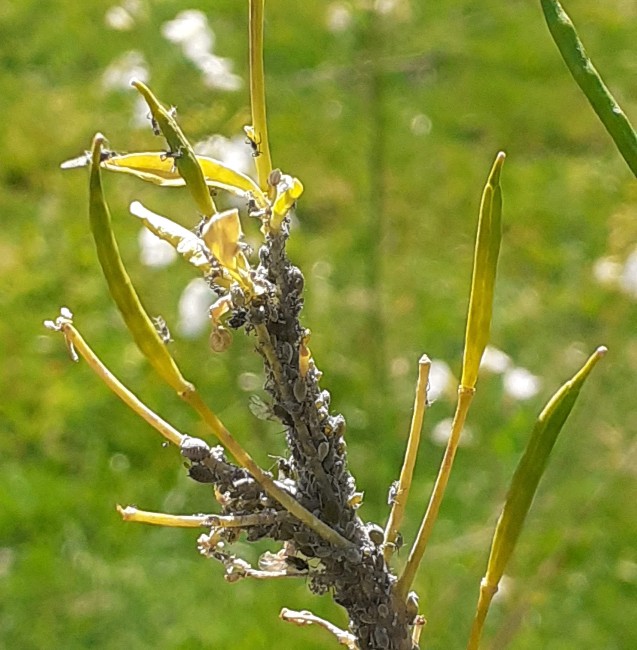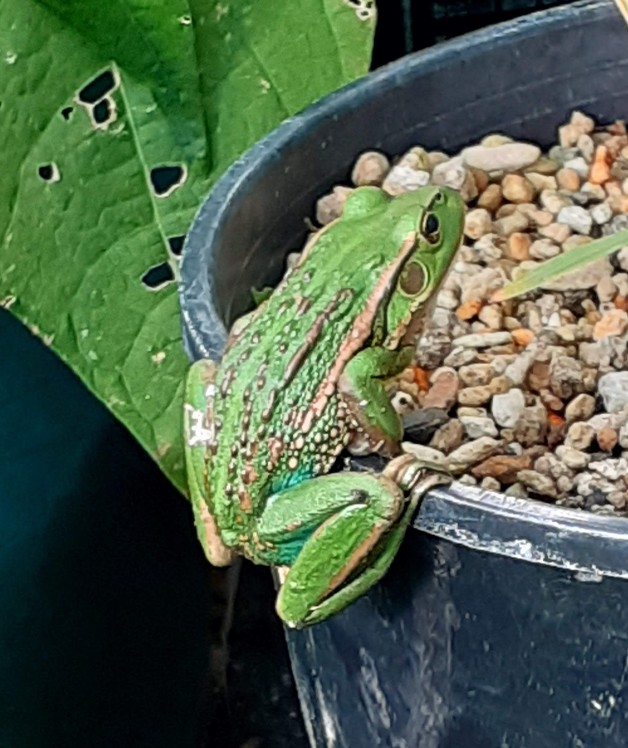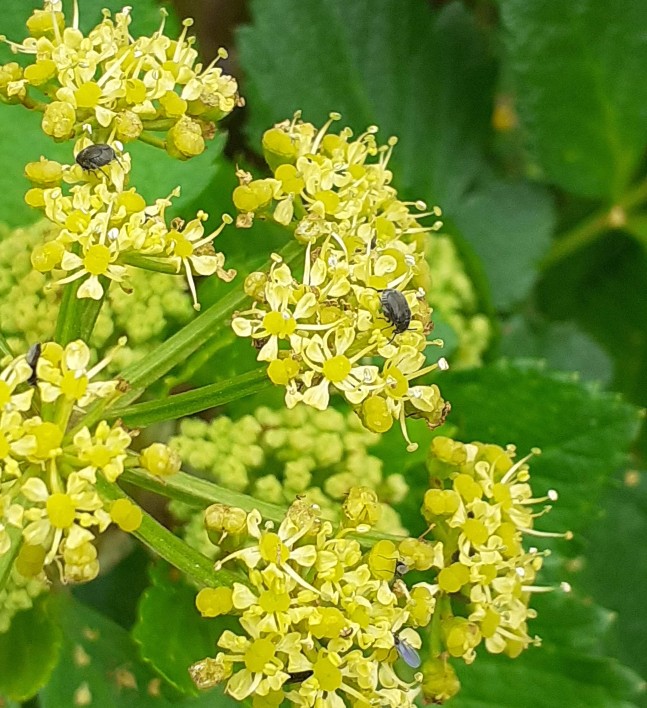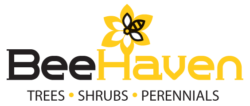
“Kill them” I hear you say when confronted with those pesky aphids- but look closer and you will see some tiny winged insects. These are parasitic wasps. The adults lay their eggs inside the body of aphids, once hatched the young will feed on the aphid bodies. Any spray even an organic one, is not selective and will kill these aphid predators too. Pest species are designed to breed quickly as they are at the bottom of the food chain, whereas the predators are much slower to multiply – so you may end up with more pests than before you sprayed.
This radish plant has also provided much more than food for aphids. It has flowered for months providing nectar for our honey bees, and more recently monarch butterflies. The young flower buds can be eaten- looking rather like small broccoli flowers with a mild radish flavour. A few will also set seed which I’m unlikely to harvest but the finches will have a feast. All going well the predatory wasps will breed up in large numbers on the radish plants, and my roses will be safe.
There are many predator species that will eat or parasitise common garden pests. There are several tiny wasp species in NZ, also ladybirds, praying mantis, lacewings, beatles, spiders, dragonflies, damselflies and flies. These in turn will also provide food for other creatures such as birds, lizards, and frogs.
Most bird species at this time of the year are looking for extra protein in the form of insects to feed their young. Encouraging a wide diversity of insect species to inhabit your garden means you can take advantage of their insect control services, as well as enjoying them in the garden.

Finding & Keeping Your Helpers
Understanding and providing what these predators need at all the stages of their life cycle will allow them to get on with what they do best – control pests- while you enjoy what you do best – planning and planting, or just enjoying the wildlife. To encourage and keep these useful creatures in your garden there are three main things to consider: Water, Housing, and Food.
Water
All species need it, and it may surprise you how much. A birdbath is a great place to start. Pop one near places you frequently sit for the extra pleasure of watching the birds bath and drink. In the middle of summer you will probably find bees visiting for a sip too. Grow shrubs or leave the tall stalks of flowering plants nearby. These provide a safe spot for finches, fantails, sparrows, and silvereyes to check out the surroundings before landing on the birdbath. Water also provides essential habitat for frogs, Damselflies, dragonflies, and many of the insects which are food for other species. Even a pile of soggy wet plant material provides useful habitat for the nymphs of Hoverflies – A great activity for children these holidays is to make a home for Hoverflies to lay their eggs. Hoverflies are very useful pollinators especially for carrot and Fennel. A small pond such as a repurposed bath tub or old trough can make a huge difference to the diversity of wildlife in your garden.

Housing
Creating homes for your garden friends is the best way to ensure they are on hand to provide pest control services. Birds need safe places to build their nests, as well as building material. Dense shrubs such as native corokia and coprosma are great for small birds such as finches, with the bonus of berries which tuis and other species enjoy in winter. Don’t be in a rush to cut back the seed heads of your shrubs and perennials, not only do they provide food for seed eaters, they eventually provide stalky nesting material too. Try to fit some trees into your garden. If space is limited think about trees which have multiple uses e.g. flowers for birds and bees, berries or fruit for birds or humans, and canopy for shade and nest building.
Many insects also need dry places to hide in the winter. A bug motel is a great way to provide lots of little hiding places, is easily made from found objects, and a great school holiday activity.
Some insects also need specific host plants for laying their eggs. Swan plants for the monarch butterfly caterpillars, whereas the native yellow and red admiral butterflies need nettles. Both the annual (Urtica urens) and the perennial (Urtica dioica) can be planted in a patch behind a low hedge such as lavender to ensure your family is safe from the stings. They are such a great plant for food and medicine too. The blue butterflies prefer various wild legumes such as clovers, (Trifolium spp.) and bird’s-foot trefoil (Lotus pedunctulatus)
Some animals particularly lizards need rocks on which to sun themselves. Logs and rocks to hide under too. Include some native plants such as corokia, meuhlenbeckia, and grasses. Making a lizard garden is a great project for older children.

Food
Many insects and birds need nectar from flowers, but not just any flower will do. Some flowers don’t produce nectar, or very little, or the shape and design of the flower can make it difficult to access the nectar. For example while honey bees love the flowers of tagasaste (tree Lucerne) it is difficult for them to access the flower, and they depend to some extent on Bumble bees to open up the flower first. Rosemary flowers are perfect flowers for honey bees as the nectar and pollen is readily accessible, and it even has a little landing platform for them. A favourite for many predatory wasps are all the members of the Umbelliferae family (now known as Apicaeae – though I prefer the former as the flowers remind me of umbrellas) these include all of the following common garden plants: Coriander, fennel, carrots, parsnip, parsley, dill, angelica, sweet cicely, and yarrow to name a few. Look closely at these flowers and you will realise that they are made up of umbels of tiny but very open flowers which are readily accessible with only a small tongue – which probably explains why a magnifying glass is required to Identify the visiting insects.
New garden varieties of flowers are often bred for fashion rather than function, with both pollen and nectar being difficult to access. The old fashioned flowers, have been around for a long time because they know what it takes to survive – accessibility to pollinators, and usefulness to humans.
The following list of species will provide a rich source of nectar, and can all be grown easily in Hawkes Bay. This list includes some shrubs, perennials and annuals.
- Daisies and plants with daisy like flowers -calendula, asters, sunflower, cornflower, marguerites, shastas, olearias, (native tree daisies), echinacea, rudbeckias .
- Salvias/ sages
- Mints
- Oregano and marjoram
- Thyme
- Hyssop
- Cosmos
- Phacelia
- Hebes
- Comfrey
- Alyssum
- Buckwheat
- Meadowfoam (limnanthes)
- Bergomot (Monarda spp.)
- Euphorbias
- Lavenders
- Choisya ( Mexican orange blossom)
- flaxes (Phormium spp.)
- Golden rod (Solidago spp.)
- Agastache
- Brassicas (radish, mustards, broccoli, kale etc )
- Umbelliferae family (as mentioned above)
Insects especially pollinators predominantly use smell, to find suitable plants. Try planting in blocks rather than a few here and there so that insects can easily find them. Many of the above plants will readily self seed too, providing another source of food for birds.
Reduce the stress of wanting to control pests in your garden and remember they are dinner for others. Your garden can be a haven for your family and wildlife.
For those who would like more information about insects in the garden I would recommend any books and ‘YouTube’ videos by Dave Goulson. Dave Goulson is based in the U.K. but has visited NZ. His writing is entertaining and informative.

